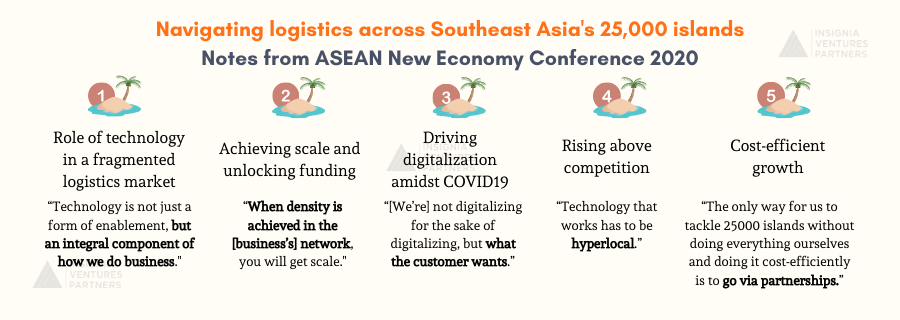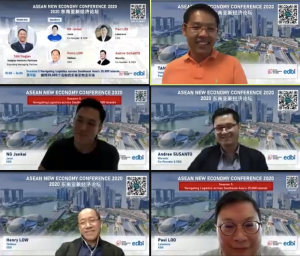Southeast Asia’s 25,000 islands are both boon and bane for logistics in the region. On one hand, you have a fragmented landscape, both in terms of geography and the supply chain processes, that makes it costly and challenging for businesses to transport goods within and across borders. On the other, the very same fragmentation opens up opportunities for technology to revolutionize how logistics is done in the region, especially as ecommerce continues to rise in adoption across goods and markets in the region.
At the ASEAN New Economy conference held virtually on 15 October 2020, our managing partner Yinglan Tan moderated a panel to discuss these opportunities. On the panel were logistics technology leaders in the region: Janio Asia co-founder and CEO Junkai Ng, Lalamove COO Paul Loo, TikiNow CEO Henry Low, and Waresix CEO and co-founder Andree Susanto. We compiled and curated five key insights from the panel below.

Takeaways from the ASEAN New Economy Conference 2020 panel on “Navigating logistics across Southeast Asia’s 25000 islands”
The role of technology in Southeast Asia’s logistics
With the increasing pressure of ecommerce demand for backend logistics to keep up, logistics technology platform across the supply chain journey have emerged. The challenge is that in emerging markets, running logistics operations is both challenging and costly given the archipelagic geography of countries like Indonesia and the traditional supply chain routes and regimes long used for cross-border trade.
According to Waresix’s Andree Susanto, this is where technology steps in, “The role of technology is to improve information flow, standardization and automation, effectively matching supply and demand across land, sea, and air solutions.”
But for logistics technology (logitech) companies, improving logistics in the region does not mean building out or acquiring entire infrastructure enabled by technology, meant to replace existing supply chain stakeholders.
Instead, logitech companies introduce technology as a key component to Southeast Asia’s supply chains. This means having technology at the core of the business. In Janio’s case, 70% of their business is run by technology, with the majority having no human intervention.
“Technology is not just a form of enablement, but an integral component of how we do business,” says Junkai Ng, CEO and co-founder Janio Asia.
Logitechs then have to integrate themselves into existing processes in order to eventually improve them. What does this look like from a user experience perspective? Lalamove COO Paul Loo points out that technology puts the gears in motion for logistics both out on the stage and behind-the-scenes.
“Technology plays important role in what people cannot see (i.e. algorithms, efficient matching between users and drivers) and [what people can see] or user interfaces (i.e. driver navigation, communication between the users and drivers)…”
While the edge of logitech companies ultimately lies in technology, building this technology stack is not a one-shot effort. The exact role of technology in improving logistics continues to evolve as the company grows, and the company’s tech stack and capabilities become a key differentiator across players.
“It is a constant iterative process,” according to Junkai, and “after building a certain level of tech stack, it becomes a data play — how [do we] improve allocation and capabilities?”
Read more about the data play from the perspective of Vietnam trucking tech company LOGIVAN >>>
Unlocking scale and funding with network density
In China, many logistics technology companies were able to scale quickly due to the homogenous market, which made it relatively easier to navigate regulations. This has allowed these companies to achieve greater valuations in a shorter amount of time, and thus raise greater funding rounds, further fuelling innovation.
In Southeast Asia, the complexity of sending products from market A to market B with varying customs regulations and multiple ports of entry has actually opened up more room for different logistics solutions across sections in the value chain (from first mile to last mile). At the same time, the various points of go-to-market have also resulted in a highly competitive space, with lower margins compared to other sectors.
Building the company’s network holds the answer to opening up opportunities for margins and scaling in this complex and competitive space.
From a supply chain perspective, building one’s network means focusing on activities that will scale and tapping into partnerships (i.e. building out the company’s network) for other capabilities. “We only build whatever can scale, and what customers need,” says TikiNow CEO Henry Low. “Leverage infrastructure that is already available and key players already in the field to deliver the best customer experience.”
From a product perspective, this means being modular to cater to a wider variety (or network) of use cases and customers that can even cross-pollinate later on in terms of monetization.
And being modular relies on the company’s technology capabilities. As Andree Susanto puts it, “Having an asset-light model requires a strong tech stack for you to operate, [and] it will enable you to be modular.”
The goal of growing the business’s network of partners and customers is to create density. This density means there’s a many-to-many value exchange or even monetization opportunities across the company’s network of partners and customers. For example, Janio’s network of logistics partners is able to open up various transport permutations for their customers.
“When density is achieved in the [business’s] network, you will get scale,” says Waresix’s Andree Susanto.
And once this scale is achieved, margins can improve over time, and opportunities for greater funding rounds will present themselves. The network density also inherently offers optionality that creates a better customer experience.
The COVID19 upgrade for logistics tech companies

ASEAN New Economy Conference Panel on Navigating Logistics in Southeast Asia’s 25000 islands
COVID19 and varying quarantine measures across Southeast Asia have impacted company operations. To deal with the impact, logistics tech companies have had to embrace flexibility in different ways depending on where the businesses are located across the supply chain.
For TikiNow and Lalamove, whose businesses engage directly with end consumers, they needed to develop offerings to adapt to changing consumer preferences. According to Lalamove’s Paul Loo, “F&B vertical just went through the roof. It taught us to be very flexible in our offering.”
Meanwhile, TikiNow CEO Henry Low says, “The consumer behavior shift was very obvious, from consumer electronics into groceries and FMCG, [and] affected the services they provided.” TikiNow launched a couple of programs like TikiPro to expand grocery services from urban to rural.
For Janio, as a 4PL platform, they needed to deal with the impact of COVID on transport options and logistics lanes. As CEO Junkai relates, “When countries went into lockdown, aviation restrictions create a supply-side squeeze…we went into some form of panic mode to really move fast to adapt to other transport alternatives.”
And this is where being technology-centric came in handy. “[Adapating to other transport alternatives] was not really a brand new experience for us. Instead of air freight, we were looking for other lanes.”
Although they were forced to build new capabilities under time pressure, Junkai says there were “[low] expectations because of COVID, [and this] gave us some breathing space to maneuver.”
Aside from maneuvering the business to deal with the impact, COVID19 has also proved to be a “good time to convince partners to adopt technologies,” as Waresix’s Andree Susanto put it.
There have been inherent challenges to bringing digital logistics players onto digital platforms. “It’s meant to be that way,” says Junkai, “Previously there was always some form of natural resistance for certain parts of the chain like customs…” But thanks to COVID19, customers have become more sophisticated and providers more open to adopting digital solutions.
That said, digitalization should still be customer centric, according to Junkai. “While it has always been part of our operating methodology since day one, [we’re] not digitalizing for the sake of digitalizing, but what the customer wants.”
Andree cites the FOMO effect as a motivation for this industry momentum towards digitalization. “They’re willing to use apps so they don’t fall behind their peers.”
And catering to this industry momentum goes back to building networks, and for technology platforms that means being able to API connect. According to Lalamove’s Paul, digitalization has been an opportunity for them to “diversify across verticals…grab the opportunity to grow faster [than their competition] and [produce] better economics….and increase their pace in building APIs and new business opportunities.”
Rising above the competition
We’ve mentioned that the complex terrain of Southeast Asia’s market has produced many smaller players in the ASEAN logistics market. Then there has also always been the threat of global incumbents like DHL and Fedex focusing their digitalization capabilities on Southeast Asia. This brings into the game a momentum towards consolidation, especially by larger homegrown players to compete against regional and global incumbents.
According to Lalamove’s Paul Loo, instead of consolidation by bigger players, there’s still room for “strong partnerships between small [and] medium players [to compete] with bigger players,” but “when [the bigger players] can’t do it themselves, then they will acquire.”
For Janio’s Junkai, he sees consolidation from the technology perspective, where a platform like theirs “enable smaller players like SMEs to punch above their weight class, [and] there is plenty of room for that to happen.”
When it comes to the threat of incumbents, TikiNow CEO Henry says that “as long as you provide a business that has great unit economics, whether it’s just warehousing, first mile, last-mile…You provide services that people struggle to replicate.”
Defining this starting point is key, as it determines how well the company can expand its services to cover the supply chain end-to-end. And because of the desire to provide better customer experiences, this race to expand along the supply chain is inevitable. Then comes the challenge of balancing scale with supply chain coverage, which Henry says can be achieved through partnerships.
As Henry says, “Whichever economy you are in, the consistent fact is that best customer experience is when you have the inventory in your hand and you control first-mile and last-mile, but is this scalable? [The] priority is to build a base that is consistent and reliable then leverage the bigger players who have been around a long time have enough volume to cover enough areas at a pricing that is sustainable.”
That said, in the face of competition from larger logistics tech players and incumbents, the panelists point out that Southeast Asia’s diverse terrains offer advantages to the smaller, emerging players who have mastered localization.
As Waresix’s Andree put it, “Technology that works has to be hyperlocal.”
Navigating logistics in Southeast Asia’s 25,000 islands
Ultimately, to navigate logistics in Southeast Asia’s 25,000 islands, you can’t be an island. “The pace of competition is so strong, you don’t have to be by yourself. There is a lot of excess capacity out there. Why build your own when you can find people you can provide the right SLA at the right price? Leverage the market while you’re building your own [platform],” says Henry.
As we’ve noted from the role of technology to achieving scale and driving digitalization, partnerships is the common thread that ties all of these aspects of the logistics technology business together.
“From my point of view, the only way for us to tackle 25000 islands without doing everything ourselves and doing it cost-efficiently is to go via partnerships,” says Junkai.
Paulo Joquiño is a writer and content producer for tech companies, and co-author of the book Navigating ASEANnovation. He is currently Editor of Insignia Business Review, the official publication of Insignia Ventures Partners, and senior content strategist for the venture capital firm, where he started right after graduation. As a university student, he took up multiple work opportunities in content and marketing for startups in Asia. These included interning as an associate at G3 Partners, a Seoul-based marketing agency for tech startups, running tech community engagements at coworking space and business community, ASPACE Philippines, and interning at workspace marketplace FlySpaces. He graduated with a BS Management Engineering at Ateneo de Manila University in 2019.